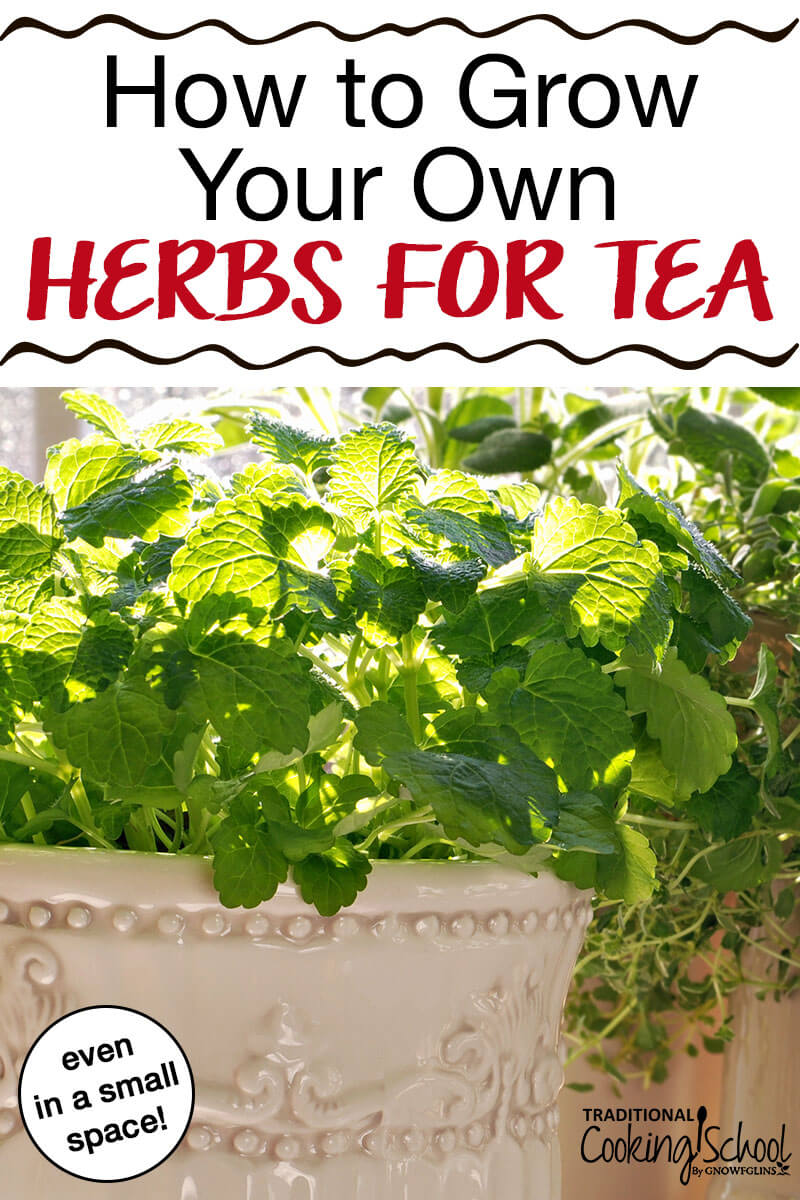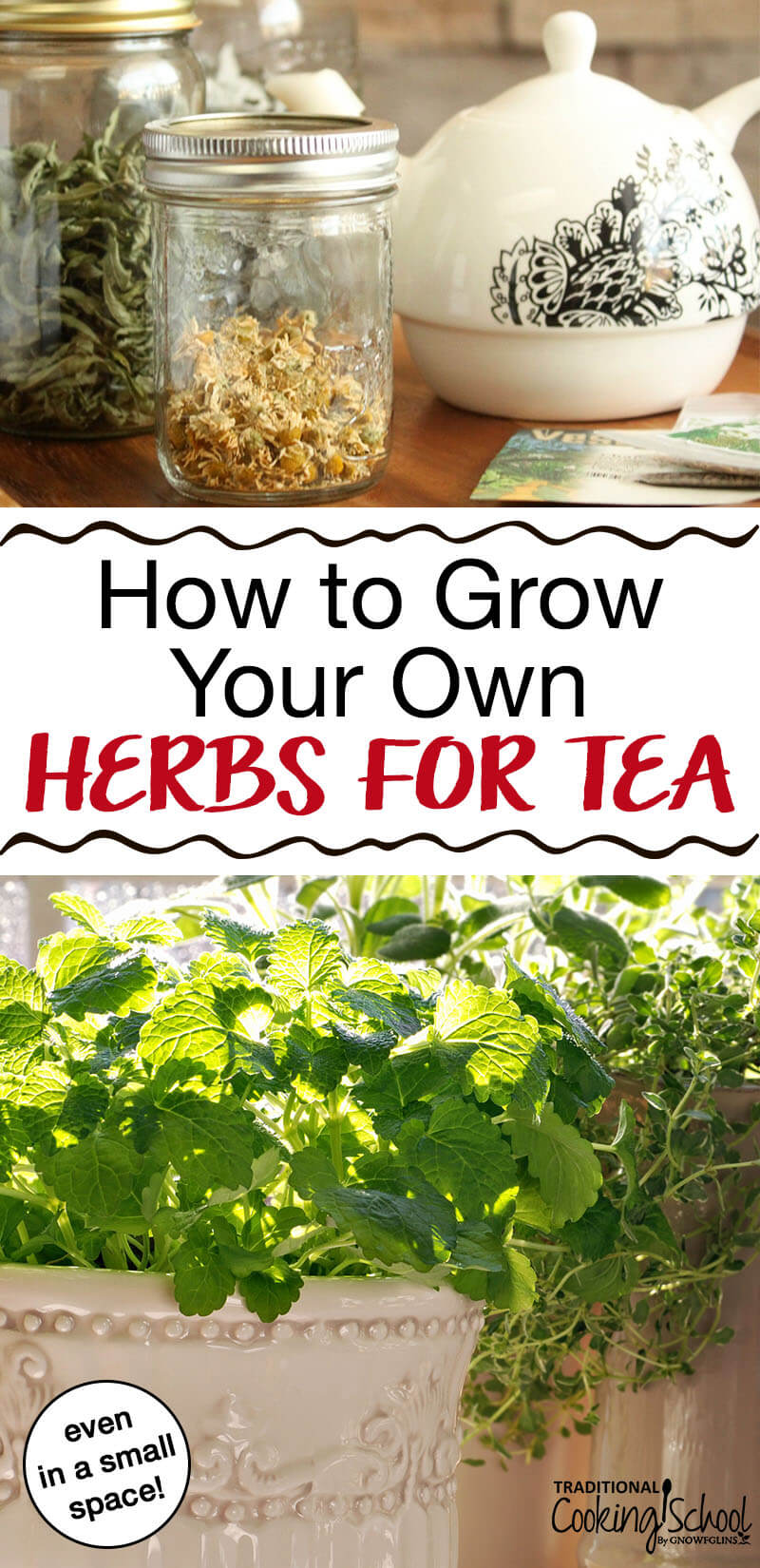
Herbal tea is easy and rewarding to grow yourself. Many tea herbs are easy-to-grow and do well in pots and small spaces, so you can enjoy delicious home-grown tea year-round.
My first tea garden was a large, rambling, free-formed plot that took up a good portion of our garden space. I happily let the plants intermix and didn’t worry (too much) about plants that liked to invade every spare spot — after all, I had lots of room!
After our recent move, my tea garden is now contained in one square-foot box, and lots and lots of pots. I have quickly learned how to make the most of our small space and have discovered that it is possible to grow enough herbs to use, dry, and store — no matter your garden size.
Although you can make tea out of almost any herb, here are five (plus one more) of my favorites for both large and small gardens!
Lemon Verbena
Lemony-scented and refreshing, I drink this tea all year long, either on its own or mixed with other herbs. Given a tiny bit of garden room, Lemon Verbena will grow into a beautiful bushy plant, with lots of leaves to dry and store for winter. Leaves can also be used fresh and make lovely lemony iced tea. Grow in well-drained soil in full sun, or in a large pot. Grown as an annual unless you live in the tropics or over-winter your pot indoors.
German Chamomile
This is a lightly-flavored tea herb known for its calming properties. Often grown en masse in large gardens, the secret to a bountiful harvest from a few plants is to harvest the flowers as soon as you see them, and then keep harvesting throughout the season. I harvest a full Mason jar of dried flowerheads in one season, all from a few plants in the corner of my garden.
Grow this annual from seed in full sun. Although not recommended for containers, I have successfully done so, but prefer to use a small bit of garden space for a better harvest.
Lemon Balm
Another lemony favorite! On top of a refreshing lemon flavor, it is also a calming herb often used to combat stress, anxiety, and insomnia. Leaves can be used fresh or dried and are wonderful for iced tea, too.
This perennial can take over the garden if you let it go to seed. Cutting it back often (while making delicious tea) will develop a bushy plant and stop seeds from forming. It grows well in a pot, but be sure to water often! Can be grown in full sun and partial shade. If you grow it in a pot, try storing it in a cool, dark spot during the winter months and it will often come back in the spring.
Mint
This is a standard tea herb. Peppermint is a perennial favorite and aids in digestion. Spearmint was a new one for me this year and the fast favorite of my visiting tea-drinking friends. It can be used fresh all season and then dried for winter use. Mints of all types are aggressive spreaders and are best grown contained, unless you have a large space and are happy to have it wander.
This perennial grows well in partial shade and in most soils. It does very well in pots, but remember to keep them watered! Similar to Lemon Balm, potted mints can be overwintered in their pots in a cool dark place.
Anise Hyssop
This makes a lovely licorice-flavored tea. Both leaves and flowers can be harvested for tea and used fresh or dried. This perennial loves full-sun and well-drained soil. It does very well in a small garden space, or can be planted in pots. Use a larger pot to encourage larger plants and flowers.
Raspberry Leaf (for larger gardens)
I had to tack this on as an extra as it is not conducive to small gardens. However, it is a wonderful tea herb, and if you have the space it is a rewarding plant to grow. Red Raspberry leaf tea has a taste very similar to traditional tea, but without the caffeine! It is lovely both hot and iced.
It is a perennial that should be grown in full sun and well-drained soil. They do take a bit of care in pruning, but the harvest is worth it. For tea, choose young leaves, dry them, and store until ready to use.
Do you have a tea garden? What are your favorite herbs to grow?
Looking for organic herb seeds to start your own? Traditional Cooking School loves Peaceful Valley Farm Supply. When you get there, type “organic herb seeds” in the search bar and a beautiful selection will pop right up.
...without giving up the foods you love or spending all day in the kitchen!

2 free books:
Eat God's Way
Ditch the Standard American Diet, get healthier & happier, and save money on groceries...
We only recommend products and services we wholeheartedly endorse. This post may contain special links through which we earn a small commission if you make a purchase (though your price is the same).



Anise hyssop is supposed to be an easy to grow perennial for my tricky climate. I am hoping to put some in this summer. I love the concept of a tea garden and have always wanted one.
I planted Anise hyssop for the first time last year and it grew very well here. It has pretty blooms, too!
I want to grow nettles for making tea during the spring allergy season. I wonder if they also can take over the garden. I already have lemon balm and sage trying to do that, although I’m learning the value of frequent trimming.
Yes, Terri, nettles do spread! I have been wanting to plant some, too, but everything I have read about them says they are very invasive, and not easy to get rid of with their sting! Like mint, they will quickly take over a garden and all areas in between! I am thinking of trying them in a large container, but as they spread by seed as well, I am wary. Most herbalists suggest Nettles as a plant best harvested wild (although I have yet to find any growing locally!)
Nettle does spread but is a fantastic companion plant and a great repellent for pests in the garden.
I have volunteer nettles growing all around my compost container the past couple years. Last year I cut it and boiled it but because I was unsure I used the correct parts I discarded it. I’ve read though to use the leaves so I will try it again this year. The slapping my arthritic joints with a stem leaves me a little uneasy as I’m not a great fan of this feeling when grazing past it, let alone slapping myself with it :} If anyone else knows how to use this more I would be appreciative.
You can also use nettles as a green, which may help keep it in check.
Thank you for these ideas! I have already purchased chamomile seeds, but I have both Roman and German…do you know what the difference is?
Also, is Red Raspberry Leaf just the leaves from the plant that bears red raspberry fruit? I have a patch, and I have been purchasing red raspberry leaf tea for all of its great qualities. It would be great to have my own supply!
About the Raspberry leaves?? Are you just harvesting the leaves from your Raspberry plants or is there a specific plant for herbal tea?
Yes, just the regular raspberry plants! No special plants needed. 🙂
Nettle tea could be on this list.
I love nettle tea, but have had no luck growing nettles in containers and am afraid to plop them into the garden because they can be invasive. If you have tips for growing nettles in a small space, please share!
I’m new to this, but very excited to make my own tea. So, how do you prepare the herbs for the tea? Do you dry and put them in loose tea bags or keep them fresh? Any other steps I need to know? Thanks!!
We have long, cold, snowy winters here, so I dry all of my herbs so I can have tea all year long. I store them in glass jars until ready to use. However, in season, all but the camomile can be used to make tea right off the plant. You will always want to use dried chamomile flowers – I either leave them out to dry or use my dehydrator. There are no special steps – just steep them in hot water like you would with any tea. Have fun!
I have the same long, snowy winters, so I appreciate your method. Thanks so much, I’m excited to keep this in mind when I plant this Spring!
The Red Raspberry Leaf Tea is the best for child birth & cramping during the months cycle. Drink a cup a day during pregancy. The key is to allow it to seep for 20 miminute. I was able to do natural childbirthnaturalwith LAMAZE.
Does the type of raspberry matter for tea leaves? I don’t have the space for raspberries unfortunately (yet), however my parents have a HUGE raspberry patch at their new house!
The type of raspberry plant doesn’t matter. Enjoy! It looks like you’ll have plenty for tea!
As long as it’s a raspberry, the type shouldn’t matter, and spring is the perfect time to harvest the young leaves!
This seems like a silly question, but which part of the chamomile plant is good for tea? Whenever I use the leaves it’s incredibly bitter.
No question is silly! Always best to ask. The flowers of the chamomile plant are used for tea. They have a sweet apple like flavor.
Chamomile flowers are best for tea, and they should be dried first.
I have to say I’ve never given a though to growing the herbs for tea. Buying the dried loose flavored tea is quite expensive! Thanks for the walk-through.